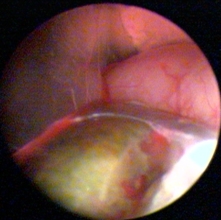Endoscopy for Avian Patients
Endoscopes are small "telescopes" that are used to have a look at the internal organs of an animal. Just as a veterinarian does a thorough physical examination of the outside of the body, the endoscope allows a veterinarian to do the same sort of examination of the bird's internal organs to assess their health. This is extremely helpful to determine an underlying cause for many illnesses that elude detection through bloodwork and other routine diagnostic labwork.
Celioscopy is the name of the procedure where the endoscope is inserted into the body of an anesthetized bird. Depending on what organs need to be examined, the procedure may be done on the left side, right side, or belly of a bird. The incision is small, less than 1/2" long in most cases.

This is a view of the liver of an African grey parrot. The liver is abnormal in color and larger than it should be.
Once a bird has been thoroughly examined with the endoscope, the veterinarian may decide that biopsies of one or more internal organs are needed to better assess the patient's health. Fortunately this can easily be done with a special tool that slides down a tube in the endoscope. The doctor can see exactly what he or she is doing and can also monitor the biopsy site afterward to make sure there is no abnormal bleeding. After the celioscopy is completed, the small hole in the bird's side where the scope entered is closed and the bird is woken up from anesthesia.

This is the same liver as above after the biopsy. The liver's color is different because a protective capsule over the liver was removed as part of the biopsy procedure. A small spot of blood shows where a portion of the liver was biopsied.
Once a bird has been thoroughly examined with the endoscope, the veterinarian may decide that biopsies of one or more internal organs are needed to better assess the patient's health. Fortunately this can easily be done with a special tool that slides down a tube in the endoscope. The doctor can see exactly what he or she is doing and can also monitor the biopsy site afterward to make sure there is no abnormal bleeding. After the celioscopy is completed, the small hole in the bird's side where the scope entered is closed and the bird is woken up from anesthesia.
Photo: This is the same liver as above after the biopsy. The liver's color is different because a protective capsule over the liver was removed as part of the biopsy procedure. A small spot of blood shows where a portion of the liver was biopsied.
The endoscope can also be used for other procedures aside from a celioscopy. It can be used to evaluate the cloaca, crop, and trachea. In many cases the birds can go home the same day as their endoscopic procedures if they do not need hospitalization for their conditions.

